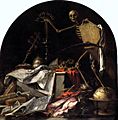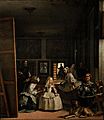Spanish Golden Age facts for kids
The "Siglo de Oro," which means "Golden Age" in Spanish, was a very special time in Spain. It was a period when Spanish art and literature became incredibly famous and important. This amazing era happened around the same time that the Habsburg family ruled Spain.
The Golden Age doesn't have exact start and end dates, but it lasted for more than a century! It began around 1492. This was when the Reconquista (a long period of Christian kingdoms taking back land from Muslim rule) ended. It was also when Christopher Columbus made his first voyage to the New World. Another big event was the publishing of the first Spanish grammar book by Antonio de Nebrija.
Politically, the Golden Age is often considered to have ended around 1659. This was when the Treaty of the Pyrenees was signed between France and Spain. However, in art and literature, it lasted a bit longer. The last great writer of this period, Pedro Calderón de la Barca, died in 1681. His death is usually seen as the true end of the Golden Age for arts and culture.
Contents
What Was the Spanish Golden Age?
The Spanish Golden Age was a time of great power and influence for Spain. It was also a period of amazing creativity. Spain became a leading country in Europe. This was thanks to its vast empire and wealth from the Americas. This wealth helped support many artists and writers.
Why Was It Called the Golden Age?
It was called the "Golden Age" because everything seemed to shine! Spain had a strong army and navy. Its explorers discovered new lands. Most importantly, its artists, writers, and thinkers created masterpieces. These works are still admired today. It was a time when Spanish culture truly flourished.
Art and Artists of the Golden Age
Spanish art during this period was very powerful and emotional. Many paintings had religious themes. They often showed saints, miracles, or scenes from the Bible. Artists used strong colors and dramatic lighting.
Who Were the Famous Painters?
Some of the most famous painters of the Golden Age include:
- Diego Velázquez: He was the main painter for King Philip IV. Velázquez is known for his realistic portraits. His most famous painting is Las Meninas, which shows the royal family.
- El Greco: Born in Greece, he moved to Spain and became a master. His paintings are known for their long, stretched-out figures and bright, unusual colors. He often painted religious scenes.
- Francisco de Zurbarán: He was famous for his religious paintings. Many of his works show monks or saints. He used strong contrasts between light and shadow.
- Bartolomé Esteban Murillo: Murillo painted many religious works, especially of the Virgin Mary and the Christ Child. He also painted everyday people, like children. His style was softer and more gentle.
Golden Age Architecture and Buildings
During the Golden Age, many grand buildings were constructed. These buildings showed Spain's power and wealth.
- El Escorial: This huge complex near Madrid was built by King Philip II. It was a palace, a monastery, a library, and a burial place for kings. It shows the serious and powerful style of the time.
- Plaza Mayor: In Madrid, the Plaza Mayor is a famous public square. It was used for markets, festivals, and even bullfights. Its grand design reflects the importance of public spaces.
Literature and Writers of the Golden Age
The Golden Age was also a golden time for Spanish literature. Many new forms of writing appeared. Plays, poems, and novels became very popular.
Who Were the Great Writers?
- Miguel de Cervantes: He is perhaps the most famous Spanish writer of all time. His masterpiece is Don Quixote. This novel tells the story of a knight who imagines adventures. It is considered one of the greatest books ever written.
- Lope de Vega: He was an incredibly productive playwright. Lope de Vega wrote hundreds of plays! His plays were very popular with all kinds of people. They often mixed comedy and drama.
- Tirso de Molina: Another important playwright, he is known for creating the character of Don Juan. Don Juan is a famous figure in literature who is known for being a charming but dishonest person.
- Pedro Calderón de la Barca: He was the last great playwright of the Golden Age. His plays often explored deep philosophical ideas. One of his most famous works is Life Is a Dream.
Music of the Golden Age
Music also thrived during this period. Composers created beautiful religious music for churches. They also wrote secular music for entertainment.
- Tomás Luis de Victoria: He was one of the most important composers of the Renaissance. His music was mostly religious. It is known for being very expressive and spiritual.
Spain's Power and Exploration
The Golden Age was a time when Spain was a global superpower. Its empire stretched across the world.
- Exploration and Colonies: Spanish explorers like Christopher Columbus opened up new trade routes. Spain gained vast territories in the Americas, Asia, and Africa. This brought immense wealth, especially gold and silver.
- Habsburg Rulers: The Habsburg kings, like Charles V and Philip II, ruled Spain during much of this period. They used Spain's wealth and power to defend their empire and spread Catholicism.
End of the Golden Age
The Golden Age eventually came to an end. Spain faced many wars and economic problems. However, the art and literature created during this time left a lasting legacy. They continue to inspire people around the world.
Images for kids
-
In ictu oculi ("In the blink of an eye"), a vanitas by Juan de Valdés Leal
-
Las Meninas (1656, English: The Maids of Honour) by Diego Velázquez
-
The Birth of the Virgin by Francisco de Zurbarán
-
The Virgin of the Rosary (1675–80) by Bartolomé Esteban Murillo
-
Cathedral of Valladolid's façade
-
Contemporary printing of the sheet music for Tomás Luis de Victoria's Officium Defunctorum.
-
Cervantes' Don Quixote (1605), original title page
-
Title page of a comedy by Spanish playwright Lope de Vega
See also
 In Spanish: Siglo de Oro para niños
In Spanish: Siglo de Oro para niños
















